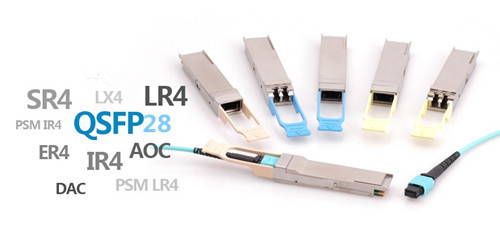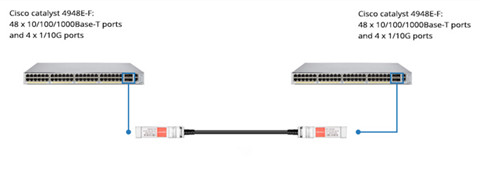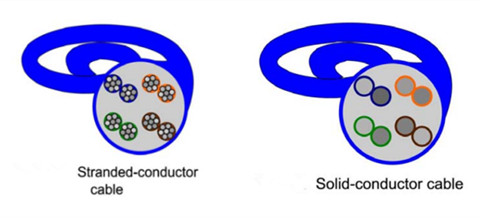QSFP28 100G Transceivers & DAC Guide
ponedjeljak , 27.02.2017.Telecom industry embraces the prosperity of 100G optics market in 2017. With such a bright future, fiber optic market attracts a wide attention, and many vendors want a piece of the pie. The 100G optics like the CFP, QSFP28 modules and cables are varied in different standards. QSFP28 100G, along with its compact size and reliable performances, gradually becomes the mainstream form factors of the 100G optics market. QSFP28 modules come in different standards (LR4, SR4, PSM4, CWDM4), and the QSFP28 AOC and DAC cables are also available for 100G systems. Which one is ideal for your 100G network? This article attached with the detailed information of all the 100G optics, will blew your mind.

QSFP28 DAC Inside Rack: <5 m
QSFP28 passive DAC cables are launched to decrease the cost of 100G systems, which provide a cost-effective I/O solution for 100GbE connectivity within 5 m. QSFP28 to QSFP28 DACs and QSFP28 to 4x SFP28 DACs are the two common types of the QSFP28 DAC cables. QSFP28 to QSFP28 direct attach cable is usually used inside racks with QSFP28 connectors terminated on each end. QSFP28 breakout DACs can achieve 25G to 100G transmission with a QSFP28 connector on one end and 4 SFP28 connectors on the other end. If your 100GbE deployment is within 5m intra racks, the QSFP28 DAC is ideal for you.
QSFP28 AOC: Up to 100 m
The QSFP28 AOC is a cost-efficient, four-channel optical transceiver that conforms to the QSFP28 multi-source agreement. It is capable of delivering 100-Gbps data rates over four lanes of 25 Gbps with a reach of up to 100 m, maximum. Just as the QSFP28 DAC, QSFP28 AOC cable also comes in two types—QSFP28 to QSFP28 AOC and QSFP28 to 4SFP28 AOC. The former one is best fit for 3-20 m, and QSFP28 breakout can support a link length of up to 100 m. The QSFP28 AOC supports InfiniBand EDR and 100 Gigabit Ethernet (100GBase-SR4) transmission speeds and is best for close-range, high-speed transmission in data center networks, such as between servers and server racks.
QSFP28 SR4 Close Range: 5-100 m
For 100GbE cabling with multimode fiber between switches, QSFP28 SR4 with 12-fiber OM4 MTP fiber cable is the perfect choice. It can support reaches up to 100 m over OM4. The 100Gbase-SR4 QSFP28 module achieves four lanes of 25G dual way transmission over eight fibers. QSFP28 SR4 module is compliant with 100GBASE-SR4 standard certificated by IEEE. It is the firstly published 100G standard to support short distance over multimode fibers. Many vendors offer the compatible QSFP28 SR4 optics with good quality and high reliability. FS.COM is one of the best that can provide the test-assured OEM optics with great customer feedback. All the products included in the below chart are provided at FS.COM.
![]()
QSFP PSM4 Between Switches: 100 m-500 m
For 100G connectivity, if the reaches are beyond 100m but less than 500m, you can use the QSFP PSM4. Unlike the QSFP28 SR4 optics (by IEEE), PSM4 standard is published by MSA. 100G PSM4 QSFP28 is designed to support a transmission distance up to 500 m over MPOI single-mode multi-fibers.
QSFP CWDM4 Mid-Reach: 500 m-2 km
Reaches less than 2 km are usually called mid-reaches. QSFP28 CWDM4 is the module designed to meet the mid-reach requirements. MSA published 100Gbase-CWDM4 standard for QSFP28 over single-mode up to 2 km over through duplex LC interface. It uses WDM technologies like 100Gbase-LR4. But the transmission distance is shorter and the cost is much lower.
QSFP28 LR4 Long Span: d10 km
For long distance transmission between two buildings, the IEEE standard 100Gbase-LR4 is being used in QSFP28 form factor which is known as QSFP-100G-LR4 module. Unlike QSFP-100G-SR4 modules, QSFP-100G-LR4 uses the WDM technologies for four 25G lanes transmission. The four 25G optical signals are being transmitted over four different wavelengths. It has a duplex LC interface for 100G dual-way transmission. 100Gbase-LR4 QSFP28 can support transmission up to 10 km over single-mode fiber. But one problem is that the cost of QSFP28 LR4 is very high now. What’s worse, you would need the EDFA to offset the link loss.
Conclusion
To achieve higher data-rate transmission speed, new network design will work to bring us closer to meet the needs of a Big Data future. This article concludes the features of existing QSFP28 100G products on the market. After going through the whole passage, you must know which one is ideal for your network.
Oznake: QSFP28 100G, QSFP28 AOC, 100G QSFP28 SR4, QSFP28 optics, 100G QSFP28, 100G optics
komentiraj (0) * ispiši * #
Use Case for 10G/40G Switch-to-Switch Interconnect
srijeda , 15.02.2017.In addition to 10 GbE, the telecom market nowadays is also actively deploying 40 GbE connections to support server connectivity, the typical use case is switch-to-switch interconnects. In fact, copper cables is used in some special cases, primarily for switch-to-switch short-reach connections. However, with the majority of 40 GbE connections being optic fiber-based, fiber optic cables, especially the MTP/MPO cables are widely deployed. From a cable plant standpoint, continued investment in fiber parallel-optic technologies will position the physical infrastructure for eventual migration to 100 GbE and beyond. This article will provide available physical cable technologies for 10G and 40G connectivity.
10 GbE Cable Solutions
Higher transmission speeds require us to implement new cable technologies to optimize our 10 GbE infrastructure:
- 10GBASE-T.
This connection over unshielded or shielded twisted-pair cables can support distances over 100 meters (330 feet) with Category 6a cable, 55 meters with Category 6 cable, and 45 meters with Category 5e cable. Category copper cables like cat5e and cat6 cable reel are the most commonly used types. We are using limited 10GBASE-T to serve the high-density connectivity within racks. 10GBASE-T has some cost advantages but it also consumes more power than optical technology.
- Small-Form-Factor Pluggable (SFP+) direct-attach cables.
These twinaxial cables support 10 GbE connections over short distances of up to 7 meters. Some suppliers are producing a cable with a transmission capability of up to 15 meters.

Figure 1 shows a simple and economic sulution for you, just connecting two Cisco Catalyst 4948E-F Switches with a 10G SFP+ Passive Direct Attach Copper Twinax Cable.
- MPO cabling.
We are using this technology to simplify cabling and reduce installation cost because it is supported over SFP+ ports. One trunk cable that we use can support 10 GbE up to 90 meters and provides six individual connections. This reduces the amount of space required to support comparable densities by 66 percent. The trunks terminate on a variety of options, providing for a flexible system.

Figure 2 shows the Interconnection for 10-Gbps Connectivity with MTP Multimode Fiber Optic Trunk Cable, 12 Fiber, Polarity B.
We use an MPO cable, which is a connectorized fiber technology comprised of multi-strand trunk bundles and cassettes. This technology can support 1 GbE and 10 GbE connections and can be upgraded easily to support 40 and 100 GbE parallel-optic connections by simply swapping a cassette. The current range for 10 GbE is 300 meters on OM3 MMF and 10 kilometers on SMF.
40GbE Switch-to-Switch Interconnects
A 40 GbE switch-to-switch interconnect can use one of three methods.
- QSFP+ transceivers and MMF MPO trunks.
This configuration must use a Method B polarity MPO trunk.
- Long-range QSFP+ transceiver and standard 2-strand SMF connections.

Figure 3 shows two 40G QSFP+ transceivers connected by a single mode LC cable. This configuration is used where switch-to-switch interconnects span between data centers or buildings within a campus.
- Active optical cable.
This is a pre-terminated parallel-optic solution which incorporates a 12-strand MMF bundle connected on each end with a QSFP+ transceiver. This type of cable is available in standard lengths up to 100 meters. This configuration is used for 40 GbE connections that span rows within the data center.
Conclusion
The existing 100Mbps and 1GE connections no longer support growing business requirements, so here comes the era of 10G and 40 GbE data center fabric design. The new fabric will reduce data center complexity and increase our network agility to meet growing data center needs. Today’s article offer the suitable fiber optic solutions for 10G/40G switch to switch interconnects. For more information about the products mentioned above, please visit our site.
Oznake: cat6 cable reel, QSFP+ transceiver
komentiraj (0) * ispiši * #
Understanding Bulk Ethernet Cable: Stranded or Solid Ethernet Cable
subota , 04.02.2017.There are a dizzying number of bulk Ethernet cable type available on the market, corresponding to a array of standards detailing the configuration and performance specification needed to support the increasingly faster data rates and larger bandwidths of incoming technologies. Of which stranded and solid Ethernet cables are the commonly used cable types when purchasing bulk Ethernet cable. These two different types refer to the internal conduction inside the bulk Ethernet cable. Today’s article provide the detail information about these two copper network cables.
Stranded and Solid Ethernet Cable
Stranded Ethernet cable has multiple smaller strands of wires that are twisted together to form a single conductor. And a solid Ethernet cable is just fabricated with a single solid strand of copper for each of the 8 conductors. Figure 1 shows the inner structure of the stranded and solid Ethernet cable.

From the above picture, we can see that each of the conductors inside a solid Ethernet cable is made up of a single, solid conducting wire with diameters between 22 and 24 AWG. Take cat6 bulk cable as an example, it employs the larger 23 AWG copper wires, which makes it better suited to new and emerging fast Ethernet applications (than cat5 bulk Ethernet cable). However, owing to the fragility of their conducting wires, the solid Ethernet cables are well-packed inside a strong outer sleeves that resists bending making them less flexible and not well suitable to normal everyday use in connecting work area component.
However, stranded Ethernet cable is the one that we most often work directly with. Unlike the solid Ethernet cable, the stranding of the wire conductors serves to protect them, and provide stranded cables their flexibility. For a given conductor length, the more times each strand twists around the central conductor, the better the protection and greater the overall flexibility of the cable. Because of their internal difference, each of the cable types might be suitable for a specified situation.
Choosing for Backbone and Horizontal Cabling
Installing any bulk Ethernet cable type (solid or stranded Ethernet cable) into a building’s structure should be well managed by keeping long-term applications in mind. Solid Ethernet cabling with its superior electrical performance and longer runs makes it more suitable for permanent building installations. Additionally, its stability over higher frequencies means that longer time periods are possible between cable reinstallations, and its comparative frailty is not a problem when it is protected from damage by the building itself. Since solid Ethernet cable is most often used for these permanent cabling applications, it often referred to as network cable.
For horizontal cabling, solid Ethernet cables are also used spanning the distances between telecommunications rooms and work areas. In addition to performing better over long distances and at higher frequencies, the single, larger conducting wires of solid cables are much easier to terminate than the multiple fine wires of stranded conductor cables. Also, the relative stiffness of solid cable makes it preferable for use with punch down connectors on the backs of wall jacks. In contrast, the softness and flexibility of stranded Ethernet cables make working with punch down connectors or IDCs (Insulation Displacement Connectors) very difficult.
In conclusion, there is very little difference between the electrical performance of solid and stranded cables for very short lengths (below 10 meters). In modern hierarchical wiring schemes, the length limitations of stranded cables are easily met (3 m, or 9.8 ft), and the increased flexibility and durability of stranded cables make them perfectly suited for interconnecting work area outlets with workstation PCs and other end-user devices.
However, solid cables are far too fragile for frequent bending and handling, and far too difficult to manage in connecting closely spaced components. The conductors inside a stranded cable are protected by the wire strands surrounding them, so that very little of the conducting surface area is exposed to damage if the cable is accidentally cut or smashed, and the conductor is not weakened by repeated flexing and bending. Without this protection, the conducting surfaces within a solid-conductor cable are more susceptible to nicks or other irregularities that affect transmission performance and often accompany their early demise.
Conclusion
As we move toward increasingly faster Ethernet systems, the copper transmission medium would require increasingly faster frequencies and data rate. For solid and stranded cables, the differences seen in electrical activity are very little. FS.COM offers a full range of bulk Ethernet cables including the cat5 bulk cables, cat6 bulk cables, cat7 bulk cables, and copper cable assemblies. If you have any interest, please contact us.
komentiraj (0) * ispiši * #
